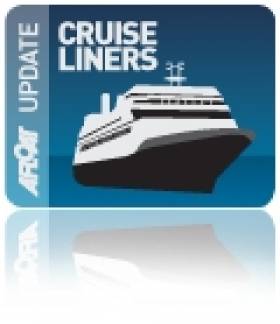Displaying items by tag: Wind Surf
#SailFlagship –The presence today of the five-masted flagship Wind Surf in Dun Laoghaire never fails to impress despite been the most regular cruiseship caller to the harbour of recent years, writes Jehan Ashmore.
All five masts of Wind Surf are notably of the same height as they stand at a commanding 221 feet (67.5 meters) high. From these masts she sets seven triangular self-furling computer-operated sails. Together the total surface are is 26,881 square feet (or 2,600 square meters).
Even when without sails aloft, Windstar Cruises magnificent motor-sailing yacht makes an impression while occupying Dun Laoghaire’s Carlisle Pier. It is alongside this pier where the 310 guest cruiseship has accommodation based exclusively of staterooms and luxurious suites. Those on board have plenty of open deck space presenting views as likewise the vantage point taken opposite from the harbour’s East Pier.
This season sees six cruiseships in total calling to Dun Laoghaire Harbour which this year celebrates its Bicentenary year. This significant historical event marks the beginning of the harbour’s construction in 1817. This involved using granite hewn from nearby Dalkey.
Originally the purpose of the harbour was as a place of ‘Refuge’. This enabled sailing ships that encountered tempestuous seas in the exposed expanse of Dublin Bay to take shelter within the harbour piers.
Roll on two hundred years and it is refreshing to have Wind Surf, albeit a wind-assisted vessel make for a graceful visitor within the harbour arms. The majestic flagship is easily the largest caller at more than 14,000 gross tonnage, however unlike previous years there are no deeper draft cruiseships. Such considerarably cruiseships have to date taken anchorage calls offshore.
The call of the luxurious 162m Wind Surf so far represents the third call this season and follows the previous visit of fleetmate, Star Pride, a conventional yet yacht-like cruiseship. Beforehand of that call the season was opened by the elegant veteran Serenissima.
In addition to recapping some details about Wind Surf, below are further facts and figures of this more unusual caller to Irish waters.
CAPACITY: 310 Guests
STATEROOMS: 122 deluxe ocean view staterooms / 31 deluxe Suites ocean view suites
BRIDGE DECK SUITES: 2 deluxe ocean view bridge suites
DECKS: 6 decks
CREW: 201 international staff
SHIP'S REGISTRY: Bahamas
LENGTH: 535 feet (162 meters) at waterline; 617 feet (187meters) including bowsprit
DRAFT: 16.5 feet (5 meters)
TONNAGE: 14,745 gross registered tons (grt)
BEAM: 66 feet (20 meters)
ENGINES: 4 diesel electric generating sets, 2 electrical propulsion motor
SPEED: 10 to 12 knots with engines only; up to 15 knots wind and engine assisted
Wind Surf Cruise Liner Under Sail from Dun Laoghaire Harbour
#WindSURF – As the five-masted Wind Surf departed Dun Laoghaire Harbour yesterday evening she began setting her sails, in stark contrast to her sister Club Med 2 as previously reported which presented only a forest of masts, writes Jehan Ashmore.
Firstly the foresail was raised as the 162m/535ft Wind Surf approached the harbour mouth and in quick succession the remaining sails where set using a self-unfurling computer-operated system from the masts that each tower 50m/164ft high. There are seven triangular sails totalling 2,600sq.m/26,881sq.feet
On board the 14,745 tonnes former Club Med I where new guests numbering 300 who had embarked in Dun Laoghaire Harbour at the Carlisle Pier. Wind Surf was making a turnaround port of call having arrived in the morning to dis-embark 280 passengers from a cruise starting in Portsmouth. Today the vessel is berthed in Belfast as part of a 7-day Gaelic Explorer cruise.
The awarding winning Wind Surf is the largest vessel in the five-strong Windstar Cruises and she launched in 1998 for then owners Club Med at a shipyard in Le Havre. She has luxurious amenities for 312 guests and with a crew of 191 that operates cruises mostly in the Mediterranean and Caribbean.





























































